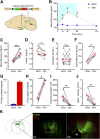Distinct Neuronal Projections From the Hypothalamic Ventromedial Nucleus Mediate Glycemic and Behavioral Effects
- PMID: 30257978
- PMCID: PMC6245222
- DOI: 10.2337/db18-0380
Distinct Neuronal Projections From the Hypothalamic Ventromedial Nucleus Mediate Glycemic and Behavioral Effects
Abstract
The hypothalamic ventromedial nucleus (VMN) is implicated both in autonomic control of blood glucose and in behaviors including fear and aggression, but whether these divergent effects involve the same or distinct neuronal subsets and their projections is unknown. To address this question, we used an optogenetic approach to selectively activate the subset of VMN neurons that express neuronal nitric oxide synthase 1 (VMNNOS1 neurons) implicated in glucose counterregulation. We found that photoactivation of these neurons elicits 1) robust hyperglycemia achieved by activation of counterregulatory responses usually reserved for the physiological response to hypoglycemia and 2) defensive immobility behavior. Moreover, we show that the glucagon, but not corticosterone, response to insulin-induced hypoglycemia is blunted by photoinhibition of the same neurons. To investigate the neurocircuitry by which VMNNOS1 neurons mediate these effects, and to determine whether these diverse effects are dissociable from one another, we activated downstream VMNNOS1 projections in either the anterior bed nucleus of the stria terminalis (aBNST) or the periaqueductal gray (PAG). Whereas glycemic responses are fully recapitulated by activation of VMNNOS1 projections to the aBNST, freezing immobility occurred only upon activation of VMNNOS1 terminals in the PAG. These findings support previous evidence of a VMN→aBNST neurocircuit involved in glucose counterregulation and demonstrate that activation of VMNNOS1 neuronal projections supplying the PAG robustly elicits defensive behaviors.
© 2018 by the American Diabetes Association.
Figures






Similar articles
-
Functional identification of a neurocircuit regulating blood glucose.Proc Natl Acad Sci U S A. 2016 Apr 5;113(14):E2073-82. doi: 10.1073/pnas.1521160113. Epub 2016 Mar 21. Proc Natl Acad Sci U S A. 2016. PMID: 27001850 Free PMC article.
-
Astrocyte glucose-6-phosphatase-Beta regulates ventromedial hypothalamic nucleus glucose counterregulatory neurotransmission and systemic hormone profiles.Neuropeptides. 2025 Jun;111:102519. doi: 10.1016/j.npep.2025.102519. Epub 2025 Mar 18. Neuropeptides. 2025. PMID: 40132240
-
Ventromedial hypothalamic nucleus neuronal nitric oxide knockdown effects on GABAergic neuron metabolic sensor and transmitter marker gene expression in the male rat.BMC Neurosci. 2025 Feb 24;26(1):14. doi: 10.1186/s12868-025-00940-0. BMC Neurosci. 2025. PMID: 39994513 Free PMC article.
-
Glucosensing neurons in the ventromedial hypothalamic nucleus (VMN) and hypoglycemia-associated autonomic failure (HAAF).Diabetes Metab Res Rev. 2003 Sep-Oct;19(5):348-56. doi: 10.1002/dmrr.404. Diabetes Metab Res Rev. 2003. PMID: 12951642 Review.
-
Hypothalamic nitric oxide in hypoglycemia detection and counterregulation: a two-edged sword.Antioxid Redox Signal. 2011 Feb 1;14(3):505-17. doi: 10.1089/ars.2010.3331. Epub 2010 Aug 17. Antioxid Redox Signal. 2011. PMID: 20518706 Free PMC article. Review.
Cited by
-
Interaction of glucose sensing and leptin action in the brain.Mol Metab. 2020 Sep;39:101011. doi: 10.1016/j.molmet.2020.101011. Epub 2020 May 13. Mol Metab. 2020. PMID: 32416314 Free PMC article. Review.
-
Nitric oxide signalling in the brain and its control of bodily functions.Br J Pharmacol. 2020 Dec;177(24):5437-5458. doi: 10.1111/bph.14800. Epub 2019 Sep 8. Br J Pharmacol. 2020. PMID: 31347144 Free PMC article. Review.
-
Central Nervous System Control of Glucose Homeostasis: A Therapeutic Target for Type 2 Diabetes?Annu Rev Pharmacol Toxicol. 2022 Jan 6;62:55-84. doi: 10.1146/annurev-pharmtox-052220-010446. Annu Rev Pharmacol Toxicol. 2022. PMID: 34990204 Free PMC article. Review.
-
Ventromedial hypothalamic nucleus subset stimulates tissue thermogenesis via preoptic area outputs.Mol Metab. 2024 Jun;84:101951. doi: 10.1016/j.molmet.2024.101951. Epub 2024 May 8. Mol Metab. 2024. PMID: 38729241 Free PMC article.
-
The sympathetic nervous system in the 21st century: Neuroimmune interactions in metabolic homeostasis and obesity.Neuron. 2022 Nov 2;110(21):3597-3626. doi: 10.1016/j.neuron.2022.10.017. Neuron. 2022. PMID: 36327900 Free PMC article. Review.
References
-
- Ritter RC, Slusser PG, Stone S. Glucoreceptors controlling feeding and blood glucose: location in the hindbrain. Science 1981;213:451–452 - PubMed
-
- Saberi M, Bohland M, Donovan CM. The locus for hypoglycemic detection shifts with the rate of fall in glycemia: the role of portal-superior mesenteric vein glucose sensing. Diabetes 2008;57:1380–1386 - PubMed
-
- Beall C, Ashford ML, McCrimmon RJ. The physiology and pathophysiology of the neural control of the counterregulatory response. Am J Physiol Regul Integr Comp Physiol 2012;302:R215–R223 - PubMed
-
- Cryer PE. Mechanisms of hypoglycemia-associated autonomic failure in diabetes. N Engl J Med 2013;369:362–372 - PubMed
Publication types
MeSH terms
Substances
Grants and funding
LinkOut - more resources
Full Text Sources
Other Literature Sources
Medical
Molecular Biology Databases

